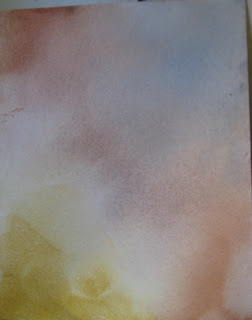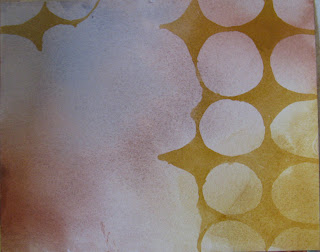I’ve been getting lots of questions about the process I’m using with my circle triads, and how to get the circles, so I decided to write up a tutorial. Painting a circle triad is actually a simple process. Explaining it however, isn’t. I wish I could just show you, but a tutorial will have to do.
I’ve split this into two posts. The first post concerns the decision making. I’m basing it on the questions I’ve been getting—how to choose the colors for a triad; what supplies are needed, etc.
Circle triads step-by-step
The colors used in this step-by-step are those from the Old Masters Triad—Yellow Ochre, Burnt Sienna and Payne’s Gray. But the steps are the same no matter what colors you are using, so I will refer to these colors as yellow, red, and blue throughout the tutorial.
Step 1. I like to start with a wash. I want the values to be light or it is difficult to build a range of light to dark. With this step, I am learning how to judge the amount of water I need for a very light wash or glaze. Colors that granulate (darker particles settle down in the paper, leaving a speckled appearance) do so when your wash is thin, so this step can also help me learn how much my colors granulate.
Wet your paper down with the Hake (pronounced Hockey) brush or dip into a pan or sink. The paper should shine with moisture.
Load your smaller brush with one of the colors and start dotting in onto the paper in one corner. Rinse your brush, load another color and dot into a different corner. Repeat with the third color. Do this quickly so that the paper is still wet. The color should pool and run on the paper.
Start tilting the paper so that the colors run into one another. Try to cover the entire paper. Add more color if necessary.
When the paint dries it should look something like this. If your colors dry too dark, then you need more water-to-paint.
Step 2. With this step, I paint the first layer of circles. I’ve exaggerated the beginning to help show how the negative painting works—I actually paint diamond-shapes rather than circles.
Load your brush with your yellowish or lightest color. Paint diamond-shapes that leave circles in negative space around them. Layer the yellow over each of the color-yellow over yellow, yellow over red, yellow over blue. But leave some red and some blue untouched. Your painting should look something like this.
Rinse and wipe your brush and load it with red, then paint some more diamonds. Paint over some of the yellow, some of the red, and some of the blue. Be sure to leave some of the blue untouched.
Don’t worry if some of your paint bleeds into the diamonds shapes that you just painted. If your paint beads up, this bleeding will happen. It’s one of the critical techniques you should learn in water painting. The effects can’t be totally controlled, but they are usually very cool. If you don’t want the bleed, then you need more paint added to the water. If you want the effect, and can’t get it, you need more water added to your paint. Note too, when the two colors mingle, what new color results.
Rinse and wipe your brush, then load it with blue and finish covering the paper. Set it aside and wait for the paint to dry.
Notice that I’ve started distorting the diamond-shapes so that I get different sized circles. I prefer different sizes, but if you want something more exact like a zentangle pattern, there is nothing wrong with that. It’s the artist’s choice.
Step 3. In this step I paint another layer of circles. Layering wet paint over dry is called glazing. If your second color is very transparent, the color beneath will show through partially. If your second color is opaque it will completely hide the color underneath. A semi-transparent color allows less of the first color to show. With this step, I am learning how transparent or opaque my colors are and what colors I get through this method of layering.
Load your brush with yellow. Paint squarish or diamond shapes within your first layer of diamond-shapes to create new circles. If you have trouble understanding this step, watch Linda Kemp’s video. http://www.jerrysartarama.com/art-lessons/Artists/Linda-Kemp/Linda-Kemp-Layers-and-Negative-Space.html.
Paint new yellow (negative)circles over some yellow diamond-shapes, over some red-diamond-shapes and over some blue diamond-shapes, but leave some of each color untouched.
If your circle edges are rough (this occurs with the beaded water and mingling), you can smooth them out. You’ll be starting a process where some of your circles are more than one color.
Do the rinse and wipe, then load up with red. Paint new circles in the yellow diamond-shapes, the red diamond-shapes, and the blue diamond-shapes, but leave some of each uncolor untouched.
Repeat the process with the blue until you feel you’ve got a wide range of color mixes
At this point, if you love what you have, and feel you’ve really explored all the mixing, you can stop. But if you want to continue, go on to Step 4.
Step 4. At this point, I deviate from Linda Kemp’s method of negative painting. She you to resist painting in those negative spaces. But there they are, almost white at this point, great big unused space that I could use for more glazing.
Note in this close-up, how I sometimes create a circle that includes both a circle beneath and part of the diamond-shapes or other circles beneath. I kind of like the effect this gives—sort of like the after-images you get behind your eyelids. And you get the chance to learn a little more about color mixing. But It can get a little messy.
I do the over-circles with yellow, then red, then blue. Sometimes, I leave some circles untouched. I keep going until I think I've got as much out the painting as I'm going to get.
Old Masters Triad. Colors: Burnt Sienna, Yellow Ochre, and Payne's Gray
I hope I was able to answer most of your questions, and that you learn and have fun if you try it.
Please feel free to ask further questions. I’ll try to answer them—but remember. I’m doing this to learn myself, so I may still be looking for the answers myself, lol!












thanks for this wonderful tutorial!!!
ReplyDeleteThank you so much!
ReplyDeleteThis is fascinating. Thanks for sharing!
ReplyDeleteThank you so much for sharing this! I have watched both Nita and Linda's videos and you've really applied and blended their techniques so well. Keep going - your work just gets yummier and yummier!!! Hugs, Patty M.
ReplyDelete